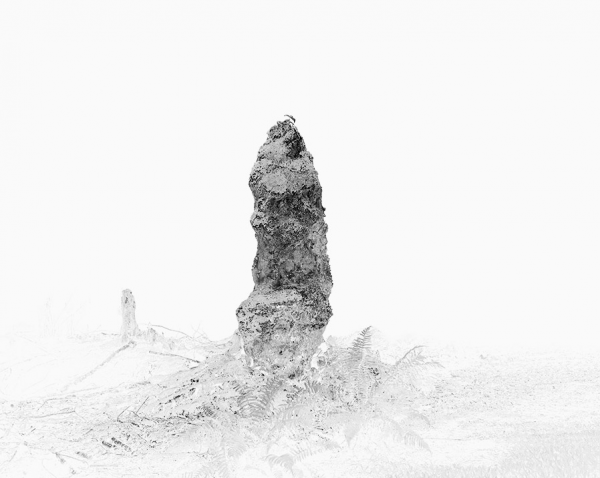Eric White
Friday, 29 October 2010
Work from Morphology.
“…new way of looking at landscape. That new way involves looking at photographs of landscapes that do not necessarily read to the eye as photographs. Stripped of any indication that we are viewing traditional color or black-and-white photographic images, we are instead left to read visual elements whose variables might be more easily found in the field of drawing and painting: line, weight and value.
Through a reverse-printing method, White extracts from his large-format negatives nearly pure form, and the inversion of tonal values in the process cuts out what might normally be extraneous to the eye or total composition, leaving us with strong lines that make up the trunks or branches of trees and delicate, barely-there tones indicating grasses and brush. Foregrounds are a delicate wash of white-ish and light gray hues, while central elements contain the greatest variation of tonal value and dark lines. The horizon is a pure, unvarying nearly-white uninterrupted canvas. If this weren’t a photo competition, you might think you were looking at an etching, an ink or a silverpoint drawing.
An emphasis on vulnerability is a principle element in this body of work: literally, the vulnerability of nature to the elements, as evidenced by the bending and yielding that trees have adapted in order to survive open and exposed conditions. But vulnerable, too, is the choice by White to render landscapes as something other than landscapes—to bring the viewer back to an ordered history of neatly rendered, but oddly intimate and formal views of the natural world, one that more closely resembles 19th century botanic drawings than a composition seen and made in the last year.
Poetic and elegiac at once, I could not help but be reminded of the images that Harry Callahan made throughout his life of the natural world. Inspired by a workshop taken with Ansel Adams in 1941, Callahan enthusiastically set about making images that were the precise inverse of Adams’ grandiose and dramatic landscapes. Training his camera on the unexceptional—but well-known to him—home landscape of Detroit, his close-in views of grasses and abstractions of open spaces became beautiful visual meditations on what and how to see something for what else it might be.
Morphology, the name White gives to this series, has a couple of meanings that are relevant to viewing and considering his work. First, there is the scientific definition: morphology is the study dealing with the form and structure of organisms apart from their inherent functions. Linguistically, morphology is the study of the structures and implied content of words. To my reading of White’s images, he both succeeds in isolating and redefining a commonly seen genre, i.e. “landscape,” and also calls into question what constitutes the flavor and meaning of those forms in our visual habits, i.e. what do we see when we see a tree against sky? Is it just and only tree and sky? And if not, what else are we seeing, and what do we call that?” – via Hey Hot Shot.



